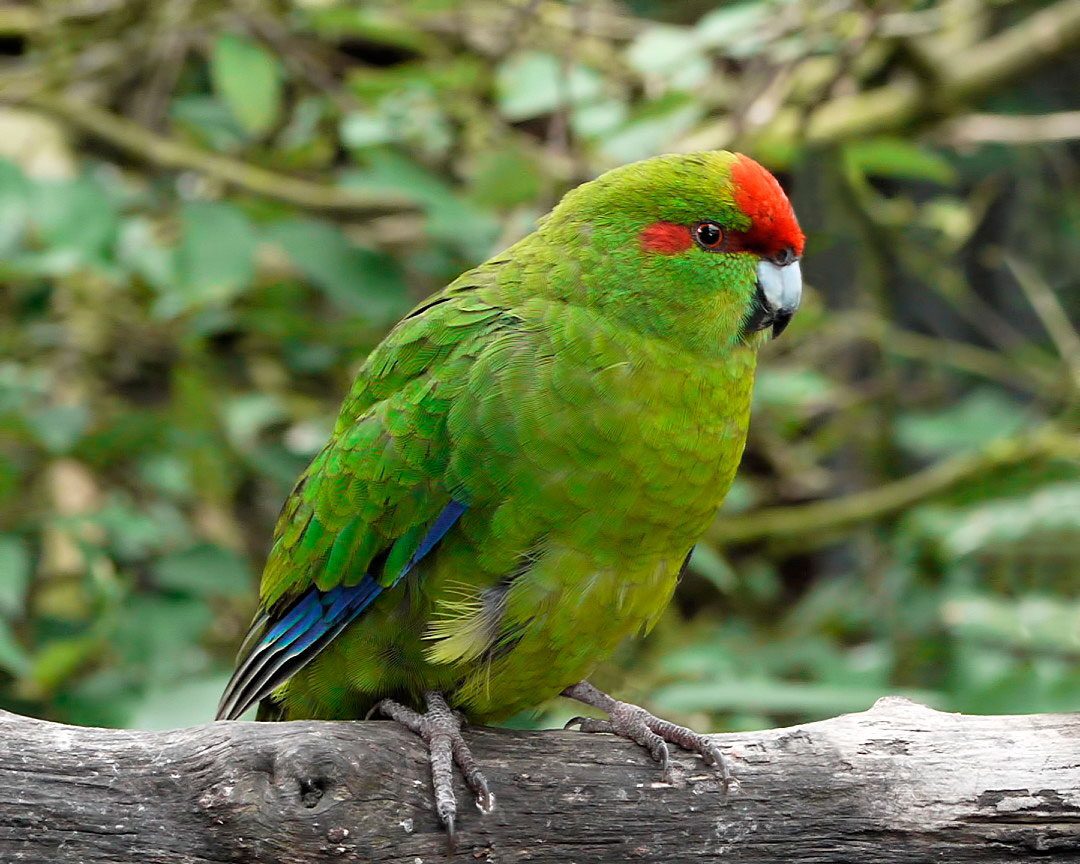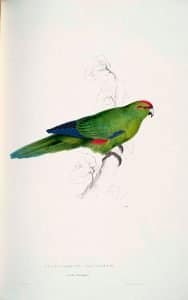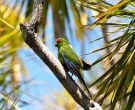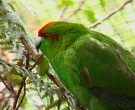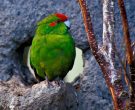Content
|
|---|
Description
27 cm.. length and a weight between 50 and 113 g..
The Red-crowned parakeet (Cyanoramphus novaezelandiae) are, generally, a brilliant green hue (sometimes with some variable yellow marks), with one frontal band crimson, lores and a line through the eye that extends to the ear-coverts; centre of crown crimson, extending back to the top of the eyes, with an area supercilii green.
Upperparts bright green uniform, with a red patch on each side of the rump. Alula, primary coverts and vane outside of the primaries are blue-violet color. Primary emarginadas with thin yellow outer margins: vane outside of the secondaries greener.
Wing feathers green: stain pale in each internal network of secondaries they form a wing bar in some males.
The underparts usually more yellowish, Green clear. Upper, the tail green; undertail, dark grey.
The bill light bluish gray, black-tipped; irises red; legs Marron-grisaceo.
Female slightly smaller.
The young birds have queues shorter, a irises reddish brown clear and less distinctive markings on the head. The younger with a pink base in the bill.
- Sound of the Red-crowned parakeet.
Description 3 subspecies
-
(Oliver 1930) – Of 28 cm approximately. It is something more than the nominal, the green of the face is Emerald, the chest is somewhat more yellowish and the legs are dark gray.
Cyanoramphus novaezelandiae chathamensis
-
(Salvadori 1891) – Of 29 cm approximately. More than the nominal, the plumage is more yellowish and the flight feather more intense blue.
Cyanoramphus novaezelandiae cyanurus
-
(Sparrman 1787) – The nominal
Cyanoramphus novaezelandiae novaezelandiae
Habitat:
The habitat of the Red-crowned parakeet includes native forest in the continental part of New Zealand, scrublands in some outlying islands and land with abundant grass in the Antipodes Islands.
The species, generally, most opted for the edges of forests and open areas to the Yellow-crowned parakeet, and the regions where the two species coexist, is, generally, at lower altitudes.
The birds tend to locate their calls when they fly over or through the forest canopy. They are most often in pairs; couples tend to remain together throughout the year. But, large groups gather where food sources are abundant at any time of the year. Where is fresh water scarce, groups of birds also tend to congregate to drink in springs or leaks.
In the Kermadec Islands, flocks are formed for bathing in tidal pools and rest on a branch (probably in other places also).
The Red-crowned parakeet they feed actively on in the early hours of the morning, they rest and groom themselves for much of the day, and is power again during the afternoon.
Reproduction:
The nesting takes place between October and March, with most laying between the months of October and December. Between two and ten (usually between five and nine) white eggs form the implementation. The eggs are deposited in a hollow of tree clad wood shavings, Although you can also have other places of sunset, including cracks in the rocks, burrows in the ground, etc, as well as a variety of nest liners including feathers, MOSS and grass.
The birds are territorial in the vicinity of the nest and can use the same site repeatedly. The incubation is carried out by the female and hard of 18 to 20 days. The pups remain in the nest during 5 to 6 weeks and the male will help with food, either through female or directly, one week after the emplumamiento.
In large litters some less developed pups can be seen. Adults undergo a post-breeding moult..
Food:
They feed on, both the canopy and soil, a wide range of vegetables, fruit, seeds, leaves, outbreaks, berries, flowers and nectar; they have priority for the seeds fallen during the autumn and winter. The species also feeds on invertebrates, honeydew and, in the Kermadec, even, algae and small macaws (Scutellastra kermadecensis).
Distribution:
The Red-crowned parakeet are in New Zealand and in a series of adjacent and outlying island groups.
Before European colonization, the species was extended by continent, but in the Decade of 1890 the population began to decline as a result of the destruction of their habitat and predation by introduced cats and mustelids.
Today the species is scarce on the continent, and they found only in larger blocks of forest, from Northland to the Coromandel Peninsula. Since Pirongia, Pureora and Hauhungaroa in the Centre of the North of the island, to Urewera, Montes Raukumara and Huiarau in the East and South of the mountains Ruahine and Tararua.
In the South of the island, the species is found around Nelson, in the Arthur's pass National Park, in the District of Dunedin and in the Fiordland National Park. Also found in a number of islands off the coast of New Zealand, where are usually more numerous than in the continent, including: Three Kings, Poor Knights (not Yellow-crowned parakeet here). Polla and Chickens, Tiritiri Matangi (introduced). Little Barrier (common), Great barrier island (scarce). Mercury, Charter, Kapiti, Stewart (and surrounding islets) and Auckland Islands (Enderby, Rose, Ewing and Adams).
The Red-crowned parakeet also found in the Group of Kermadec (Macauley, Meyer, Napier, Dayrell and Chanters, with the lagging Curtis and Raoul), Chatham Islands (rare) in Chatham and Pitt, abundant in the island's Southeast, and controlled in Mangere and Little Mangere in order to avoid crossing with the Chatham Parakeet – Cyanoramphus forbesi), and in the antipodes islands (Antipodes, Bollans, Leeward, Archway and Windward Islands).
Distribution 3 subspecies
-
(Oliver 1930) – They live in the chatham islands
Cyanoramphus novaezelandiae chathamensis
-
(Salvadori 1891) – Is located in the Kermadec Islands
Cyanoramphus novaezelandiae cyanurus
-
(Sparrman 1787) – The nominal
Cyanoramphus novaezelandiae novaezelandiae
Conservation:
• Current Red List of UICN: Near threatened
• Population trend: Decreasing
The population is, undoubtedly superior to the 15.000 specimens, although decreasing due to habitat loss and predation.
The hybridization with the Yellow-crowned parakeet (Cyanoramphus auriceps) It is also a problem in some populations.
The subspecies chathamensis is threatened, with a population of less than 1.000 specimens.
The subspecies cyanurus is still relatively common with about 10.000 individuals in Macauley. There are at least 4.000-5.000 birds in the Group of the Antipodes Islands.
captive birds they have been released in areas of Wairarapa and Waitakere. CITES Appendix I.
"Red-crowned parakeet" in captivity:
The Red-crowned parakeet are common in aviculture and is relatively easy to raise.
They can live in community with species of similar characteristics. It is usually outgoing, Active and depending on their way of breeding and previous experiences, You can be a confident Parrot, even being raised by their parents tends to be entrusted.
What pet He could be a good companion because of his way of being joyful and curious.
With regard to its longevity and according sources, one specimen was still alive after 12,4 years in captivity. It has been reported that these animals can live up to 36,5 years in captivity, but this has not been verified; the same study reported that these animals they can be played back to year of age in captivity.
Several color mutations they are available, including, yellow, the cinnamon and the overo.
Alternative names:
– Red-fronted Parakeet, Red-crowned Parakeet (English).
– Perruche de Sparrman (French).
– Ziegensittich (German).
– Periquito Fronteou-Vermelho (Portuguese).
– Perico Maorí Rojo (español)
scientific classification:

– Order: Psittaciformes
– Family: Psittaculidae
– Genus: Cyanoramphus
– Scientific name: Cyanoramphus novaezelandiae
– Citation: (Sparrman, 1787)
– Protonimo: New Zealand parrot
Images “Red-crowned parakeet”:
Videos "Red-crowned parakeet"
“Red-crowned parakeet” (Cyanoramphus novaezelandiae)
Sources:
- Avibase
- Parrots of the World – Forshaw Joseph M
- Parrots A Guide to the Parrots of the World – Tony Juniper & Mike Parr
- Birdlife
- Parromania
-
Photos:
(1) – A Red-crowned Parakeet at Nga Manu Nature Reserve, Waikanae, New Zealand By Sid Mosdell from New Zealand (GreenUploaded by Snowmanradio) [CC BY 2.0], via Wikimedia Commons
(2) – A Red-crowned Parakeet on Kapiti Island, New Zealand By Craig Nash from Northern Ireland [CC BY 2.0], via Wikimedia Commons
(3) – Red-crowned Parakeet (Cyanoramphus novaezelandiae) at Queens Park Aviary By tewahipounamu [CC BY-SA 2.0], via Wikimedia Commons
(4) – Red-crowned Parakeet (Cyanoramphus novaezelandiae) in captivity at Auckland, New Zealand. Photographed on 11 November 2002 By Arthur Chapman [CC BY 2.0], via Wikimedia Commons
(5) – Cyanoramphus novaezelandiae (Red-crowned Parakeet, Green) on Tiritiri Matangi Island, New Zealand. These parakeets are often seen foraging on the cabbage trees (Cordyline australis) on the island By Adammarklenny (Own work) [CC BY-SA 3.0 or GFDL], via Wikimedia Commons
(6) – A painting of a Red-crowned Parakeet (originally captioned “Platycercus pacificus. Pacific Parrakeet.”) by Edward Lear 1812-1888 Edward Lear [Public domain], via Wikimedia Commons
- Sounds: David Bradley (Xeno-canto)
